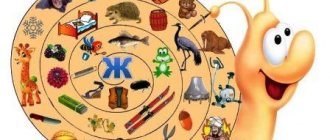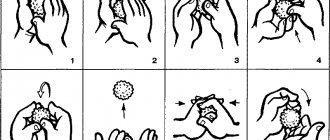July 16, 2018
Averyanova Sveta
Pronouncing the hard and soft sound “r” is rarely easy for children. In speech therapy, there is even a special “indulgence” for “l” and “r”: if for the basic alphabet the norm of development is within 4 years, then for “l” and “r” experts allocate two more preschool years - up to 6 years .
When preparing for school, teachers especially focus the attention of parents on how to teach their child to say the letter “R”. In school education, incorrect pronunciation can become a problem for a child, first of all psychological, and then communicative. A careful attitude to children's speech at 2-4 years old can correct the situation.
Deviations in the sound "r"
The production of the sound “r”, even with normal development of the child, can occur through the use of other sounds that are similar in articulation or sound (noisy speech). And if there is a problem with r-pronunciation, it becomes most pressing in the first grade.
Classmates may make fun of a burr or baying peer. This is quite unpleasant and psychologically puts pressure on the first-grader. But you can correct the pronunciation of “r” at any age, if there are no physiological restrictions for this.
When pronounced correctly, the tip of the tongue vibrates, and the tongue itself is slightly tucked up. Incorrect pronunciation of “r” can be very different depending on the method of sound substitution that the child has chosen:
- Substitution r=l : [r]fish=[l]fish, you[r]os=you[l]os, sakha[r]=sakha[l].
- Substitution p=v : [r]fish=[v]fish, you[r]os=you[v]os, sakha[r]=sakha[v].
- Substitution p=g : [p]fish=[g]fish, you[p]os=you[g]os.
- Substitution p=th : [p]fish=[th]iba, you[p]os=you[th]os, sakha[r]=sakha[th].
- Substitution p=[__] [p]fish=[__]fish, you[p]os=you[__]os, ko[r]ova=ko[__]ova.
- Guttural or guttural [r] , characteristic of the French and Germans, is obtained when a child’s soft palate or tongue vibrates when pronouncing “r”. A sound similar to French is called grassing.
- Without vibration , the English sound characteristic of the letter R appears.
- Rare cases: when instead of [r], the baby pronounces [n] or deep [s], uses lip vibration (coachman “prrr”), creates lateral vibration or nasal [r].
Automation of sound occurs quite quickly, but retraining the articulatory apparatus will be difficult and time-consuming. If at about 5 years old a child still says “r” incorrectly and has difficulty separating and combining “r” and other sounds, try to be as attentive as possible to the purity of your child’s speech.
Therefore, at the first sign of an incorrect sound, help your child cope with the problem of “growling.” Moreover, in most cases it is enough to learn a few exercises for home use and periodically devote time to them.
Articulation exercises
Before starting all the exercises, you need to do gymnastics, and only then proceed to the training itself.
Swing
Loose tongue with open mouth. You need to touch the upper and lower teeth. Periodically lingers on the top for 10-20 seconds.
Cuckoo
The tip sticks out and touches the upper lip, and then goes behind the upper teeth. The mouth should be wide open.
Painter
The tongue is passed over the teeth, cheeks, and palate. The tongue is like a brush and you need to paint the inside of the oral cavity with it.
horse
The tongue makes clicking sounds.
Treat
The tongue licks the lips clockwise.
Kitty
Lick an imaginary treat from a saucer. The tongue should not be curled.
Harmonic
You need to raise your tongue and secure it to the roof of your mouth. In this position, close your mouth.
Hammer
Smile widely and tap your lower teeth with the tip of your tongue.
Why do children growl badly?
The difficulty of reproducing sounds, including “r”, lies in their constant sonority. In speech, it can be difficult for a child to cope with the connection of sonorants with each other, with vowels, with voiceless sounds, with hissing sounds. This is an articulatory problem (cannot pronounce sound combinations) and is most often overcome by training the tongue, cheeks, lips and palate.
When a single “r” cannot be pronounced correctly, that is, growled, you need to understand the reasons.
They can be hidden both in the anatomy of the speech apparatus and in the general rates of psycho-speech development.
Advice to parents. If you are an inexperienced parent and have never encountered making sounds in preschoolers, then it would be better to get at least one speech therapy consultation to be sure that home exercises will be effective.
1. Anatomical features
- decreased tongue mobility;
- poor development of the muscles of the lips and cheeks;
- malocclusion;
- special structure of the frenulum (hyoid ligament).
Anatomical problems are solved by massage, articulation exercises, frenulum stretching or surgery. It is necessary to discuss the appropriateness of the latter with a speech therapist.
Children usually like articulation gymnastics. Because during such an activity, parents are forced to lift the ban on grimaces, sticking out their tongues and scary faces. Useful pranks with facial muscles help strengthen the articulatory apparatus, make it more mobile, and this will improve the clarity of speech in general.
2. Features of sound perception
If in a preschooler’s speech letters are constantly getting confused, rearranged, or falling out of words, phonemic hearing disorders can be suspected. On the other hand, the cause of pronunciation problems may be a banal imitation of one of the family members or older comrades.
Case from practice. A girl with impaired vision turned out to have an absolute ear for music. But at the same time, the speech apparatus had amazing inertia.
When the girl was playing with sand on the beach, her nanny said the phrase: “Now it all needs to be leveled.” The little girl tried to repeat the new word, and it came out: “un-var-nyat.” No matter how hard the nanny tried to correct the pronunciation, nothing worked. I had to tell the nanny that she needed to replace the word with a “simpler” one: even, level, level. After several repetitions at a slow pace, the girl began to correctly pronounce and read words syllable by syllable: “equalize”, and then easily connected all the sounds.
3. ENT diseases
Sometimes the cause is improper breathing (weak breathing is more common in girls) or ENT diseases: allergic rhinitis, rhinitis, tonsillitis, tonsillitis, adenoids, polyps, paresis. In each case, a unique individual treatment and a set of speech therapy exercises must be selected to restore the function of the speech apparatus.
4. Dysarthria
Neurological disorders should be highlighted as a separate item. Not only the purity of diction, but also the very ability to pronounce sounds depends on the innervation of muscles and ligaments.
Why does mispronunciation occur?
The sound R is sonorant, voiced, consonant, and is one of the most complex in the Russian language. Children begin to pronounce it later than others. Sometimes pathology drags on for many years due to the wrong approach to the problem. Long-term inactivity leads to a worsening of the situation; with age, a person gets used to saying “burly”; it is more difficult to relearn than to correct at an early age.
Incorrect articulation may result from:
- ingrained habits of incorrect pronunciation since childhood;
- speech apparatus defect: short frenulum, long or thick tongue, malocclusion, high palate;
- hypodynamia of the articulatory organs, when the muscles work weakly, a person is unable to put them in the desired position;
- incorrect speech perception, hearing loss;
- speech therapy disorders (dyslalia, alalia, rotacism, etc.);
- incorrect position of teeth.
It is necessary to determine the causes of incorrect speaking from childhood in order to facilitate correction. Problems of speech apparatus defects are dealt with by an orthodontist and a dentist. Physical inactivity can be corrected by a speech therapist, or in severe cases, together with a neurologist. When there is a problem with hearing, an audiologist and an otolaryngologist are involved in the work.
Staging a solid sound
To get started, watch a short video in which a speech therapist shows how to make the sound R for a child using several exercises.
Speech therapy exercises must be performed at home during the day. For each complex, the frequency and frequency of repetitions is individually set. Give your child short and simple instructions, like in our examples.
Breathing exercises
- «Bubble" You need to blow out as many soap bubbles as possible in one exhalation. Take a very deep breath and exhale strongly and long. Inhale again and imagine that you are blowing an even larger soap bubble.
- «flying feather" Inhale through your nose. Now, slowly exhaling through your mouth, blow a feather (a piece of cotton wool) from your palm.
Lip exercises
- «Angry dog" Show me how an angry dog growls.
- «Dudochka" We make a long pipe out of our lips.
- «Frog" The frog has a mouth, as they say, “from ear to ear.” To portray it, you need to smile very widely.
- «Whale" We puff out our cheeks. A whale swims in the blue sea, we puff out our cheeks strongly.
Tongue exercises
- «Needle" Try to make the tongue narrow and sharp. It turns out? Show me.
- «horse" The horses' shoes click loudly on the pavement. Let's depict this sound with our tongue.
- «Sweet tooth" How do you lick your lips if there is delicious jam left on them?
- «Swing" Try to reach your nose with the tip of your tongue. And now - up to the chin. Need to repeat several times.
- «Painter" When painting the ceiling, you need to move the tip of your tongue back and forth across the sky. The brush is our tongue, we will paint the ceiling.
- «tube" We stick out the tongue in the shape of a tube.
- «Sail" We open our mouth. We place our tongue up behind the teeth and begin to blow on the tongue, as if the wind is inflating a sail.
Exercises for stretching the frenulum of the uvula
Usually massage and special exercises help stretch the short frenulum of the tongue. It is better to conduct these activities in a playful way. A little patience, and the coveted “r” will appear.
- " Kitty ". The kitten eats milk, scooping it up with its tongue. Can you show how?
- Home massage . After the speech therapist shows options for frenulum correction, massage can be performed at home.
Games-activities
Ready-made script - especially for busy parents. Play daily for 5-10 minutes, no more. Avoid evaluative phrases like “Wrong!”, “Wrong!” It is more correct to say: “It will be more convenient for you this way,” “It’s better this way,” “Try this way.” Show an example of completing the task. Any subsequent lesson begins with a 5-minute repetition of already practiced sounds.
Encourage your child's efforts, his desire to complete the exercise, and independently change the plot of the game. Find good words for what is happening here, now and with this particular child. Don't remember yesterday's successes and shortcomings. Talk through what exactly happened for the child today .
Scenario 1
- " Merry Races ". Rider competition. Whose “horse” clatters its hooves faster and louder is the winner. We represent the sound of hooves by clicking the tongue.
- " Bird yard ". Depict the sounds of the inhabitants of the poultry yard. Let the child suggest them. The main goal of this exercise is to teach your baby to copy an angry turkey. It should sound something like [bl-bl-bl!] if the tongue moves quickly back and forth between the lips.
- We lingered a bit in the poultry yard.
A storm begins. Wind started to blow. Use your tongue to feel the tubercles behind the upper teeth (adult shows). Do not press your tongue too hard against the tubercles. Now stretch your lips as if you are smiling and blow hard! You can blow away light objects in this way - they are carried away by the storm. It is important to achieve a sound reminiscent of [trrr].
Scenario 2
Repetition games logically lead to a new plot with new exercises. For example, today we harnessed a horse to a cart (carriage, sleigh...), and the coachman drives it.
- «Coachman" The horse is galloping very fast today. We need to stop her. What does the coachman say when he is about to stop the carriage? [Prrr]. The sound is produced by the vibration of the lips.
- «Drum" We continue to smile. We drum, hitting the tubercles on the upper palate with the tip of our tongue. At the same time we pronounce the sound [d]. The lower jaw should not move.
- «Pancake" The exercise helps to work out the optimal shape of the tongue - wide. An adult demonstrates completing a task using a mirror. A wide, relaxed tongue rests on the lower lip, like a pancake on a plate.
- The same exercise is performed with a smile. The same wide tongue should be slowly raised to the upper teeth and used to feel the tubercles. Then slowly and widely place it on your upper lip.
Scenario 3
Don’t forget about repeating what you’ve learned and continuing the storyline of the game, weaving new exercises into it.
- Today “ Start your car engine ”. This exercise should be carefully worked through by an adult. It is important to use a mirror. We raise our wide tongue to the upper tubercles and pronounce a frequently repeated “d”: [dddddd]. At the same moment, you need to move your tongue left and right under the tip of your tongue with your index finger. Gradually the sound [dddddd] turns into [ddrrrr].
Comment. For hygienic reasons, you can use a teaspoon instead of your finger.
Repeat the exercise as often as possible. First time in front of the mirror. As soon as the sound becomes stable, auxiliary items can be gradually abandoned.
The importance of exercises for automating the letter r
There are many exercises to help teach a child to pronounce the letter r. We have given only a few examples. Don’t forget about such useful speech development activities as learning tongue twisters, reciting poetry, and retelling literary works.
After the child begins to say the letter r, it is useful to consolidate the skill. To do this, you should perform special automation exercises with your child. They include the pronunciation of straight syllables with the sound r, then words, phrases and sentences. For example: “I’m picking tomatoes in the garden. You are picking tomatoes in the garden. You... They...". In this way, correct pronunciation is brought to automaticity. It is better to carry out exercises with a child in a playful way, without coercion or persistence.
Soft “r” - [r']: [r']aba, [r']is, words [r']
Experts say that once the hard “r” is mastered, there are no more difficulties with the soft one. If it can take 5-6 lessons to practice a hard “r”, then one is enough for a soft one. The rest of the time before school, it is important for parents to work together with their child to automate all the sounds of the alphabet as a whole.
When pronouncing a soft [r'], the position of the tongue changes slightly - its back rises slightly higher to the palate, moves forward to the dentition, and the corners of the lips stretch a little wider than when pronouncing the same sound hard. It’s better to start mastering [рь] with letter combinations and syllables.
- Start with the syllables in order of complexity: [ri], [re], [rya], [re], [ryu]. For children with good musical abilities, it is quite possible to sing this sequence in scales.
- Secure the result. Repeating one syllable at a speed is an excellent game for developing diction in preschool children: ri-ri-ri, re-re-re.
- Find the words. Ask your child to choose words with these syllables, for example: rhyme , repka , ryabchik , reva , ryusha.
- With paired consonants: d/t, b/p, g/k: d rema , d ryably , tri , rag pka , t ry m, charging.
Already at this stage, everything will work out well for the baby, since the main - solid - sound has already been established. It's time to move on to words and sentences to automate pronunciation. When working with a preschooler, you should not tell him about hard and soft sounds: just offer to compare the “r” in the words “pencil” and “spine.”
Exercises to consolidate the skill
A skill is a result of learning, a stable automatic performance of an action. To automate a skill means, through repeated repetition and training, to bring it to a state where it is performed “without thinking.” To do this, it is not at all necessary to train the child with the same exercises. Oral folk art has a wealth of didactic material.
Warm-up
To warm up, remember all the syllables: [ra], [rya], [ro], [re], [ru], [ryu], [ry], [ri], [re], [re]. Repeat points 2, 3, 4 for all of them and start entertaining games with words in sayings, proverbs, tongue twisters and tongue twisters!
Little secret. Stock up on balloons! Children love them very much. Inflating balloons promotes lung development, acts as a breathing exercise, improves voice, and strengthens the muscles of the cheeks and lips.
Use growling words
Proverbs and sayings are an excellent reason to discuss moral issues with your child and work on educational topics, and the repetition of growling and hissing will happen by itself. For example, suggest discussing the following popular sayings:
- You can’t even pull a [fish] out of the pond without t[ru]d.
- Where it’s thin, that’s where it [tears].
- [Re]ka begins with [ru]cheka.
Tongue Twisters
Forcing your preschooler to do anything is not an effective strategy, but involving him in competition is a great idea. Why not use pre-prepared task cards for a family r-battle?
Take for example the story about “Karl and Clara” or “Grass in the Yard”.
Tongue twisters starting with “R” are not uncommon in specialized literature and manuals for parents. Use any of them or these examples about birds:
- The pea[re]pellings were [hidden] from the [children].
- T[ri] so[ro]ki-ta[ra]t[or]ki ta[ra]t[or]or on g[or]ke.
- To catch a smart s[or]k is a hassle, and a s[or]k is a s[oro]k.
Pure talk
Unlike tongue twisters, the pure twister technique does not imply speed: you need to pronounce it in such a way as not to make mistakes in sounds, clearly pronounce each syllable and sound. Explain the task to your child and come up with a reward for clear speech. Here are a couple of examples to get you started:
- The baby pig is chewing a carrot. B[ra]shek b[ra]nku g[ry]zes [ra]nka.
- In the d[or] on the [sidewalk] t[ri] friends were [draw]ing. She froze at [the] war: “K[ar]! [Ra]z[ris]ovan [tro]tu[ar]!”
Sound differentiation
In order for [p] not to conflict with other consonants, especially sonorous ones, it is necessary to automate not only the difficult sound, but also its combinations with others. So, to differentiate “r”, words that differ by one letter are used. Pairs of words suitable for differentiating “r”:
- Rye is a lie
- Varnish - cancer
- Laz - once.
During the day, diction exercises should take about 20-30 minutes. It is more effective when this time is divided into short episodes, games, entertaining tasks of 5-7 minutes. For a child from 3 to 7 years old, it is much more interesting to play and communicate with adults than to perform meaningless repetitions, so give preference to play methods. Children's poems, a comic rhyme and a logarithmic song on the topic of the lesson are also suitable.
Advice. Play metagrams : how, for example, can you make a sea out of a river? Very simple: [river]ka - [hand]ka - bow - puddle - bed - vine - pose - along [ra] - mountain [ra] - mountain [re] - sea [re]. At the same time, you can count within ten: how many steps did it take for the transformation? How many attempts did it take to find the chain?
Incorrect sound pronunciation must be corrected and correct pronunciation must be corrected soon, but not quickly. If you intend to correct your child’s speech on your own, then act consistently and methodically. In order not to get lost in the modern flow of information, at each stage, check the recommendations of trusted sources: consultation with a speech therapist, specialized literature or official publications of child psychologists.
Try to choose the right time for the lesson - when the child is in a good mood and ready to cooperate in the game. It is better to talk with him about sounds while studying books and fairy tales, exercises with cubes, a box of letters and the alphabet. Explain that the tongue should be taught to work, like any other muscle, without stopping training, as in sports. The fact that the tongue is a muscle can be a big discovery for some reason!
If it doesn't work out. Preschool children are not always amenable to learning and training. When something goes wrong, parents should not panic or become nervous in front of their children. Stop the activity, calm down and return to your beloved cub in a good mood.
Another important piece of advice: eliminate a bad example or draw the child’s attention to the fact that imitating such an example is bad. Sometimes children stop burring when they realize that it causes ridicule and excessive attention.
Important! Is it worth instilling in a child a sense of shame for his mistakes? Of course not! Instead of making a remark like “You’re wrong again,” turn the situation into a joke. Many phrases are remembered by the whole family and turn into fun memories. Here are examples from recent practice: coach Vareny Nikanaevich (Valery Nikolaevich), grandfather Usran (Ruslan).
Do you need professional advice?
Incorrect pronunciation can have an unpleasant long-lasting effect if the problem is not addressed promptly. The child may become more shy, embarrassed to speak in front of the class or strangers, a situation that may have a negative impact on spelling and overall literacy. Incorrect, slurred speech often leads to unpleasant consequences later in life, causing problems with communication.
There is a wide range of reasons that affect pronunciation, and they cannot always be dealt with at home; sometimes only a speech therapist can teach children to speak correctly. Although often minor illegibility is obvious and easy to correct.
In most cases, the key factors in determining whether professional speech therapy services are needed are your child's age and ability to communicate clearly. If a child over three years old is understood only by family members, this is an alarm signal indicating problems that need to be solved. If in preschool there are errors in some sounds, but they are usually understandable to outsiders, this is normal. Perhaps light exercises on pronunciation of phrases with a problematic letter will help. However, already a first-grader must master the “r” - if it doesn’t work out, you will need the advice of a doctor. The sooner you intervene, the easier it will be to correct mistakes. Too often, for whatever reason, a child does not receive adequate help, and articulation problems remain until adolescence and beyond. Intuitively, the longer a bad habit lasts, the more difficult it will be to correct it.
Teaching how to pronounce all the letters correctly is an important task for parents as they prepare their child for school. Having mastered these basic skills, the future first grader will feel more confident. By the way, you can buy a backpack for first class using the link.
Speech therapist and kindergarten
If kindergarten teachers or a primary school teacher notice a child’s diction, insufficient clarity of speech, or peculiarities of sound perception, do not neglect organized additional classes within the educational institution. In a separately formed group, where all children have speech disabilities, it is much more comfortable for them to study without embarrassment and fear of making mistakes.
The speech therapy lesson is structured so that every child takes maximum participation in it. Usually, at every stage from the organizational moment to physical education, a full-time speech therapist uses special games and exercises that help children relax and learn to speak in a new way.
Improvement in diction in a healthy and normally physically developed child occurs after the first lessons. But you need to teach him not only to mechanically reproduce sounds, but also to understand the meanings of words, to sense the difference in meaning. This will speed up and enrich the learning process.
Levina's method
Rosa Evgenievna Levina created her own method in 1965, which consisted of articulation exercises for setting the letter R. At the beginning of the lessons, the fricative R is achieved, which does not have a characteristic vibration.
- The second stage is training the sounds Zh, Sh. You need to move your lips apart, but without rounding them. In this case, you need to pull out the sound Zh and move the tip of your tongue to the top.
- At the first stage, the exercises are aimed at obtaining the fricative "P" without vibration after achieving correct articulation.
- To obtain P, D is used, which must be pronounced while exhaling. The mouth should be open and the tongue connected to the upper gums.











